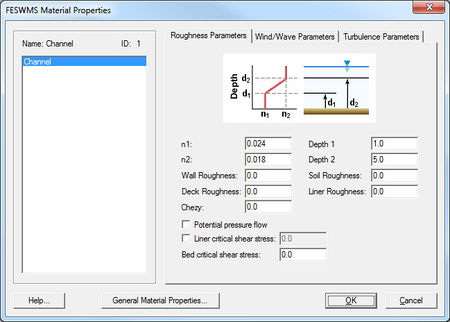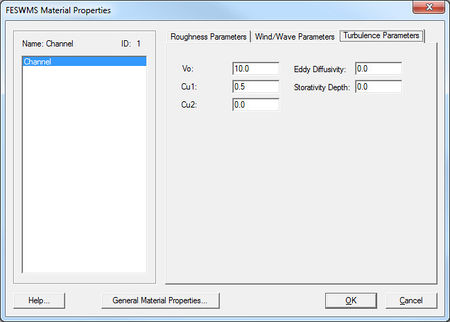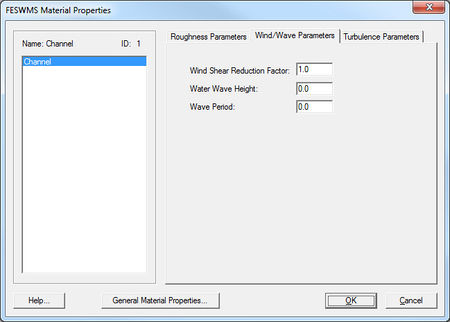SMS:FESWMS Material Properties: Difference between revisions
| Line 5: | Line 5: | ||
The roughness helps determine the energy losses as water flows over elements. Each material includes roughness information. | The roughness helps determine the energy losses as water flows over elements. Each material includes roughness information. | ||
* Manning n values (n1, n2, depth1, depth2) | * Manning n values (n1, n2, depth1, depth2) | ||
<blockquote>The primary roughness property is the manning n value associated with the element. The manning n value can vary with depth by specifying n values at two depths. The n1 value is used below depth1. The n2 value is used above depth2. Between depth1 and depth2 the n value is linearly interpolated.</blockquote> | <blockquote style="margin-top:0px; margin-bottom:0px;">The primary roughness property is the manning n value associated with the element. The manning n value can vary with depth by specifying n values at two depths. The n1 value is used below depth1. The n2 value is used above depth2. Between depth1 and depth2 the n value is linearly interpolated.</blockquote> | ||
* Wall roughness | * Wall roughness | ||
<blockquote>The wall roughness is used on the edge of the model domain. Wall roughness is ignored unless the model is using semi-slip boundaries.</blockquote> | <blockquote style="margin-top:0px; margin-bottom:0px;">The wall roughness is used on the edge of the model domain. Wall roughness is ignored unless the model is using semi-slip boundaries.</blockquote> | ||
* Soil Liners | * Soil Liners | ||
<blockquote>FESWMS can be used with materials representing a soil liner. To use a liner, turn on the linear critical shear stress and set the value. When using a liner n1, n2, depth1, and depth2 are ignored.</blockquote> | <blockquote style="margin-top:0px; margin-bottom:0px;">FESWMS can be used with materials representing a soil liner. To use a liner, turn on the linear critical shear stress and set the value. When using a liner n1, n2, depth1, and depth2 are ignored.</blockquote> | ||
* Pressure flow | * Pressure flow | ||
<blockquote>It is required to toggle on "potential pressure flow" with all materials that are assigned to elements with a ceiling elevation. If pressure flow is enabled, the deck roughness is the manning value for the bridge deck. Otherwise deck roughness is ignored.</blockquote> | <blockquote style="margin-top:0px; margin-bottom:0px;">It is required to toggle on "potential pressure flow" with all materials that are assigned to elements with a ceiling elevation. If pressure flow is enabled, the deck roughness is the manning value for the bridge deck. Otherwise deck roughness is ignored.</blockquote> | ||
* Chezy | * Chezy | ||
<blockquote>Chezy values are an alternative to using Manning n values for roughness. It's necessary to turn on chezy in the model parameters to use this value.</blockquote> | <blockquote style="margin-top:0px; margin-bottom:0px;">Chezy values are an alternative to using Manning n values for roughness. It's necessary to turn on chezy in the model parameters to use this value.</blockquote> | ||
* Bed critical shear stress | * Bed critical shear stress | ||
<blockquote>The bed critical shear stress is used to compute clear water scour.</blockquote> | <blockquote style="margin-top:0px; margin-bottom:0px;">The bed critical shear stress is used to compute clear water scour.</blockquote> | ||
=== Turbulence Parameters === | === Turbulence Parameters === | ||
Revision as of 14:19, 25 April 2016
FESWMS material properties include roughness, turbulence, and wind/wave parameters. The Materials Properties dialog is accessed through the FESWMS menu.
Roughness Parameters
The roughness helps determine the energy losses as water flows over elements. Each material includes roughness information.
- Manning n values (n1, n2, depth1, depth2)
The primary roughness property is the manning n value associated with the element. The manning n value can vary with depth by specifying n values at two depths. The n1 value is used below depth1. The n2 value is used above depth2. Between depth1 and depth2 the n value is linearly interpolated.
- Wall roughness
The wall roughness is used on the edge of the model domain. Wall roughness is ignored unless the model is using semi-slip boundaries.
- Soil Liners
FESWMS can be used with materials representing a soil liner. To use a liner, turn on the linear critical shear stress and set the value. When using a liner n1, n2, depth1, and depth2 are ignored.
- Pressure flow
It is required to toggle on "potential pressure flow" with all materials that are assigned to elements with a ceiling elevation. If pressure flow is enabled, the deck roughness is the manning value for the bridge deck. Otherwise deck roughness is ignored.
- Chezy
Chezy values are an alternative to using Manning n values for roughness. It's necessary to turn on chezy in the model parameters to use this value.
- Bed critical shear stress
The bed critical shear stress is used to compute clear water scour.
Turbulence Parameters
Turbulence parameters are used to control the energy lost in turbulence.
- Vo
Base eddy viscosity in Length^2/second
- Cu1, Cu2
Turbulence model coefficients used to modify base eddy viscosity
- Eddy diffusivity
Used to modify base eddy viscosity and is related to the amount of curves in the channel
- Storativity depth
The global storativity depth (specified in the model parameters) can be overriden on a material level by entering a non-zero value.
Wind/Wave Parameters
- Wind Shear Reduction Factor
- Water Wave Height
- Wave Period
Related Topics
SMS – Surface-water Modeling System | ||
|---|---|---|
| Modules: | 1D Grid • Cartesian Grid • Curvilinear Grid • GIS • Map • Mesh • Particle • Quadtree • Raster • Scatter • UGrid |  |
| General Models: | 3D Structure • FVCOM • Generic • PTM | |
| Coastal Models: | ADCIRC • BOUSS-2D • CGWAVE • CMS-Flow • CMS-Wave • GenCade • STWAVE • WAM | |
| Riverine/Estuarine Models: | AdH • HEC-RAS • HYDRO AS-2D • RMA2 • RMA4 • SRH-2D • TUFLOW • TUFLOW FV | |
| Aquaveo • SMS Tutorials • SMS Workflows | ||


